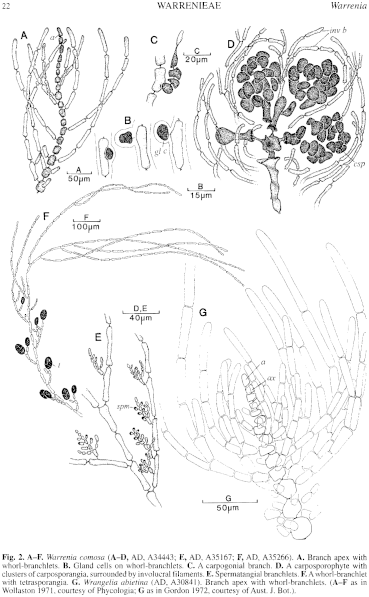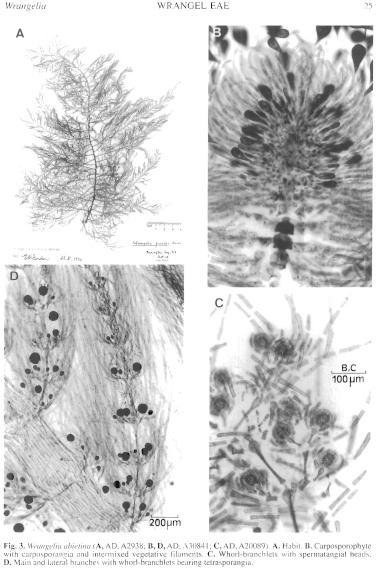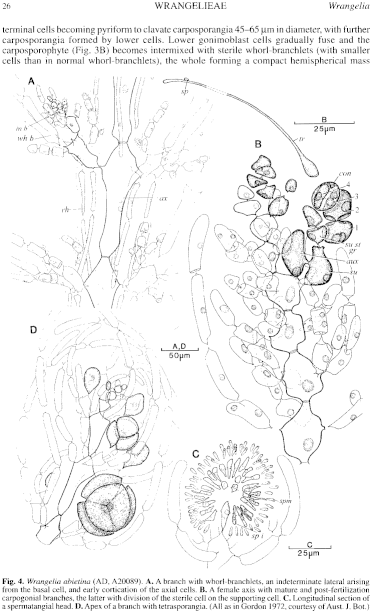|
|
|
|
|
|||||||||||
|
Electronic Flora of South Australia Species Fact Sheet
Phylum Rhodophyta – Order Ceramiales – Family Ceramiaceae – Tribe Wrangelieae
Selected citations: J. Agardh 1876: 621. De Toni 1897: 131. Gordon 1972: 38. Lucas 1909:22. May 1965: 366. Silva et al. 1996: 431. Sonder 1881:29.
Synonym
Wrangelia princeps Harvey 1862: pl. 234; 1863, synop.: xxvii. J. Agardh 1876: 624. Bornet & Thuret 1876: 184. De Toni 1897: 136. Gordon 1972: 14, figs 1–3,10H, I, 50. Lucas 1909:23; 1929b: 48. Lucas & Perrin 1947: 143. May 1965: 365. Reinbold 1899: 44. Silva et al. 1996: 433. Sonder 1881:29. Tisdall 1898: 511. Wilson 1892: 170. Womersley 1950: 181.
Thallus (Fig. 3A) medium to dark red brown, fading to grey-red, 10–30 (–60) cm high, alternately pinnately branched for 3–4 orders, lateral branches 1–20 cm long. Holdfast 1–4 mm across, rhizoidal; epilithic or epiphytic on Codium. Structure. Apical and subapical cells (Fig. 2G) small, dividing slightly obliquely and enlarging gradually to 400–700 (–900) µm in diameter and 2–3 mm long near the thallus base. Each axial cell with 5 whorl-branchlets, developed from periaxial cells usually cut off in alternating sequence, the first on alternate sides on successive axial cells. Mature whorl-branchlets (Fig. 4A) 1–2 mm long, overlapping, basally branched subdichotomously, ultimate (6–) 8–10 cells unbranched, tapering, mid cells (18–) 20–35 (–45) µm in diameter and L/D 4–7. Indeterminate lateral branches arise from basal cells of whorl-branchlets (Fig. 4A). Cortication by descending rhizoids from the basal cells of whorl-branchlets, forming a pseudoparenchymatous cortex of longitudinal filaments, 1–8 mm thick below and exposed between the whorl-branchlets. Cells uninucleate; rhodoplasts discoid to elongate, ribbon like in larger cells.
Reproduction: Gametophytes dioecious. Procarps (Fig. 4B) formed successively on the third to sixth axial cells of indeterminate apices, the supporting cell bearing a terminal sterile cell and a lateral 4-celled carpogonial branch. Post-fertilization two connecting cells are cut off from the carpogonium, and occasionally similar cells from lower carpogonial branch cells; one fuses with the auxiliary cell which produces 1–3 short gonimoblast filaments with the terminal cells becoming pyriform to clavate carposporangia 45–65 µm in diameter, with further carposporangia formed by lower cells. Lower gonimoblast cells gradually fuse and the carposporophyte (Fig. 3B) becomes intermixed with sterile whorl-branchlets (with smaller cells than in normal whorl-branchlets), the whole forming a compact hemispherical mass 600–800 across. Spermatangia are formed terminally on radiating filaments of subspherical heads (Figs 3C, 4C) 40–60 µm in diameter, borne on the lower 1 or 2 cells of whorl-branchlets, surrounded by curved involucral branchlets.
Tetrasporangia (Fig. 4D) occur on the lower 1–3 cells of unmodified whorl-branchlets (Fig. 3D), subspherical, 80–100 µm in diameter, tetrahedrally divided.
Type from Garden I., W. Aust. (Harvey, Tray. Set 270, not located in TCD); lectotype (Alg. Aust. Exsicc. 267) in Herb. Harvey, TCD.
Selected specimens: Yanchep, W. Aust., drift (Kraft 8531,20.ix.1990; MELU and AD, A66994). Point Peron, W. Aust., drift (Mitchell, 22.ix.1966; AD, A30770). Hopetoun, W. Aust., on Codium galeatum, drift (Gordon, 20.xi.1968; AD, A33183). Port Victoria, S. Aust., 3–4 m deep (Kraft, 20.ix.1973; AD, A44549). Cape Jervis, S. Aust., 10–12 m deep (Shepherd, 29.xi.1983; AD, A53782). Seal Bay, Kangaroo I., S. Aust., drift (Gordon, 29.x.1966; AD, A30841). Pennington Bay, Kangaroo I., S. Aust., on Codium galeatum, drift (Womersley, 23.i.1944; AD, A2618 and 27.i.1946; AD, A2938). Stanley Beach, S coast Kangaroo I., S. Aust., on Codium galeatum, drift (Womersley, 7.ii.1956; AD, A20089). Cat Bay, Phillip I., Vic., on Codium galeatum, drift (Womersley, 10.i v.1959; AD, A22718).
Distribution: Yanchep, W. Aust., to Phillip I., Vic.
Taxonomic notes: Gordon (1972, p. 38) considered W. abietina close to W princeps. They are now united here since the dimensions of the whorl-branchlet cells overlap considerably and the habit and whorl-branchlets are similar but distinct to those of W. plumosa. In describing W princeps, Harvey (1862, pl. 234) recorded it from Garden I., W. Aust. (Clifton 23, Aug. 1856), but made no mention of his earlier (1855a) W. ?abietina, also from Garden I.
W. abietina is closely related to the type species, W. penicillata, differing (Gordon 1972, p. 21) in greater diameter of cells of whorl-branchlets, which are more densely branched, and in absence of curved involucral filaments around the tetrasporangia.
It appears to be a deeper water alga, commonly epiphytic on Codium galeatum on rough-water coasts.
References:
AGARDH, J.G. (1876). Species Genera et Ordines Algarum. Vol. 3, Part 1- Epicrisis systematic Floridearum, pp. i-vii, 1–724. (Weigel: Leipzig.)
BORNET, E. & THURET, G. (1876). Notes Algologiques. Fasc. 1, pp. 1–70, Plates 1–25. (Masson: Paris.)
DE TONI, G.B. (1897). Sylloge Algarum omnium hucusque Cognitarum. Vol. 4. Florideae. Sect. 1, pp. 1–388. (Padua.)
GORDON, E.M. (1972). Comparative morphology and taxonomy of the Wrangelieae, Sphondylothamnieae and Spermothamnieae (Ceramiaceae, Rhodophyta). Aust. J. Bot. suppl. 4, 1–180.
HARVEY, W.H. (1855a). Some account of the marine botany of the colony of Western Australia. Trans. R. Jr. Acad. 22, 525–566.
HARVEY, W.H. (1862). Phycologia Australica. Vol. 4, Plates 181–240. (Reeve: London.)
HARVEY, W.H. (1863). Phycologia Australica. Vol. 5, Plates 241–300, synop., pp. i-lxxiii. (Reeve: London.)
LUCAS, A.H.S. & PERRIN, F. (1947). The Seaweeds of South Australia. Part 2. The Red Seaweeds. (Govt Printer: Adelaide.)
LUCAS, A.H.S. (1909). Revised list of the Fucoideae and Florideae of Australia. Proc. Linn. Soc. N.S.W. 34, 9–60.
LUCAS, A.H.S. (1929b). A census of the marine algae of South Australia. Trans. R. Soc. S. Aust. 53, 45–53.
MAY, V. (1965). A census and key to the species of Rhodophyceae (red algae) recorded from Australia. Contr. N.S.W. natn. Herb. 3, 349–429.
REINBOLD, T. (1899). Meeresalgen von Investigator Street (Slid Australien), gesammelt von Miss Nellie Davey (Waltham, Honiton). Hedwigia 38, 39–51.
SILVA, P.C., BASSON, P.W. & MOE, R.L. (1996). Catalogue of the Benthic Marine Algae of the Indian Ocean. (University of California Press: Berkeley, Los Angeles & London.)
SONDER, O.W. (1881). In Mueller, F., Fragmenta Phytographiae Australiae. Supplementum ad volumen undecinum: Algae Australianae hactenus cognitae, pp. 1–42, 105–107. (Melbourne.)
TISDALL, H.T. (1898). The algae of Victoria. Rep. 7th Meet. Aust. Ass. Adv. Sci., Sydney, 1898, pp. 493–516.
WILSON, J.B. (1892). Catalogue of algae collected at or near Port Phillip Heads and Western Port. Proc. R. Soc. Vict. 4, 157–190.
WOMERSLEY, H.B.S. (1950). The marine algae of Kangaroo Island. III. List of Species 1. Trans. R. Soc. S. Aust. 73, 137–197.
The Marine Benthic Flora of Southern Australia Part IIIC complete list of references.
Publication:
Womersley, H.B.S. (24 December, 1998)
The Marine Benthic Flora of Southern Australia
Rhodophyta. Part IIIC. Ceramiales – Ceramiaceae, Dasyaceae
©State Herbarium of South Australia, Government of South Australia
Illustrations in Womersley Part IIIA, 1998: FIGS 2G, 3, 4.

Figure 2 enlarge
Fig. 2. A–F. Warrenia comosa (A–D, AD, A34443; E, AD, A35167; F, AD, A35266). A. Branch apex with whorl-branchlets. B. Gland cells on whorl-branchlets. C. A carpogonial branch. D. A carposporophyte with clusters of carposporangia, surrounded by involucral filaments. E. Spermatangial branchlets. F. A whorl-branchlet with tetrasporangia. G. Wrangelia abietina (AD, A30841). Branch apex with whorl-branchlets. (A–F as in Wollaston 1971, courtesy of Phycologia; G as in Gordon 1972, courtesy of Aust. J. Bot.).

Figure 3 enlarge
Fig. 3. Wrangelia abietina (A, AD, A2938; B, D, AD, A30841; C, AD, A20089). A. Habit. B. Carposporophyte with carposporangia and intermixed vegetative filaments. C. Whorl-branchlets with spermatangial heads. D. Main and lateral branches with whorl-branehlets bearing tetrasporangia.

Figure 4 enlarge
Fig. 4. Wrangelia abietina (AD, A20089). A. A branch with whorl-branchlets, an indeterminate lateral arising from the basal cell, and early cortication of the axial cells. B. A female axis with mature and post-fertilization carpogonial branches, the latter with division of the sterile cell on the supporting cell. C. Longitudinal section of a spermatangial head. D. Apex of a branch with tetrasporangia. (All as in Gordon 1972, courtesy of Aust. J. Bot.)

|
Email Contact: State Herbarium of South Australia |

|